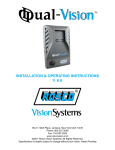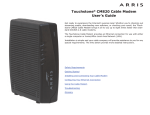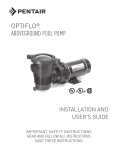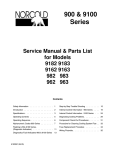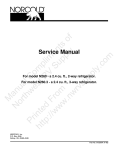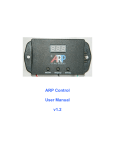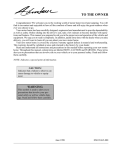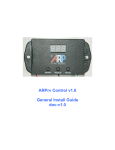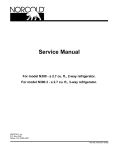Download Norcold Ice Maker Service manual
Transcript
Ice Maker Trouble Shooting Procedures Ice Maker Specifications Ice Maker Requirements: Volts: 120 volts AC Amp Draw - cycle on, heater off: .03 amps Amp Draw - cycle on, heater on: 1.6 amps Amp Draw - cycle off: 0 amps Inlet water pressure: 15 - 125 psi. Duration of 1 cycle: 3.5 to 7 minutes Ice Yield: 3 lbs./24 hours 1. Cold potable water supply at pressures between 15 psi and 125 psi. 2. 120 Volts AC supply - 108 VAC min -132 VAC max. 3. 1/4" O.D. cooper tubing (compression nut, compression sleeve, and 90° degree tubing adapter supplied with refrig erator) or an approved plastic tubing. 4. 1/4" Shut-off valve in water supply line. (Should be accessible when the lower vent door is open.) Problem/Probable Cause/Remedy Problem 1. Refrigerator Cooling: No ice in bin Probable Cause 1. 2. 3. 4. 5. A/C power disconnected. Broken wire or loose connection. Shut off arm in storage position. Water supply shut off. Inoperative water valve. 6. Excessive frost build-up causing Shut-off arm to hang up. 2. Low ice yield. 1. Ventilation of refrigeration not in accordance with Norcold’s Venting Requirements. See Section 2. 2. Insufficient refrigeration. 3. Not enough water supply pressure. 4. Thermostat setting too warm. 3. Excessive water dripping on ice cubes or from Ice Maker mold. 1. Excessive water pressure. 2. Water valve sticking open. Remedy 1. 2. 3. 4. 5. Connect A/C power. Locate and repair. Place in normal operation position. Restore water supply. Check valve and inlet filter for restrictions or solenoid coil failure. Repair or replace. 6. Defrost unit - inspect for door gasket leak. 1. Install in accordance with Section 2 of this manual. 2. Check 120 VAC power 108 VAC min. - 132 max. 12 VDC Power 10.5 VDC min. - 15.4 VDC max. 3. A. Check for restrictions in water lines or water valve. B. Check for correct water pressure. min. 15 PSI; max. 125 PSI 4. Adjust Thermostat setting. 1. Correct water pressure min. 15 PSI max. 125 PSI 2. Check for contaminated inlet filter or replace water valve. 4. Ice maker mold overfilling with water. 1. Defective water valve. 1. Replace water valve. 5. Ice cubes are milky or have taste. 1. Water hardness or food stored in ice bin. 1. Advise customer to have water supply inspected and refrain from storing food in the ice bin. 1 C503 Trouble Shooting Procedures These check-out procedures are based on: * * * * * 12 Volts DC (Control Voltage) is available to the Refrigerator. 120 Volts AC is available to the refrigerator and to the Ice Maker. Water pressure to the Ice Maker is at 15 psi min. - 125 psi max. Thermostat is set at mid-range setting or higher. Refrigerator is performing satisfactory and has been operating long enough to reach ice making temperatures. * The Ice Maker’s shut-off arm in the down ON position. Location of Test Test points are located behind the white cover plate. To gain acccess to the test point, the ice maker is required to be moved from the freezer. Test Points 5/16" Mounting Screws Ice Maker Removal 1. Remove the ice bin and shelf. 2. Remove the two 5/16" mounting screws. 3. With a Phillips screwdriver, remove the 2 screws under the Ice Maker. 4. Pull Ice Maker forward to remove. 5. Remove white cover plate. 6.Follow Check Out procedures. White Cover Plate Ice Bin Shelf FIGURE 1 Note: The wire harness is equipped with a thermal fuse. The fuse protects the ice maker mold from overheating. If the fuse is open, the wire harness rerquires repplacement. Wire Harness Check - Figure 6 The wire harness has a thermal fuse. The fuse protects the ice maker mold from overheating. If the fuse is open, the wire harness requires replacement. Use a volt ohmmeter and check for 120 volts AC between test points L and N. Note: Insure your meter leads contact the surfaces of the test points. If 120 volts is present, proceed to "Water Valve" check out. If 120 volts is not present, replace the ice maker’s wiring harness. FIGURE 2 2 C503 Water Valve Check Energizing the Water Valve Caution: To prevent an electrical shock, use an insulated jumper wire. Note: If water is available to the water valve, performing the procedure below may overflow the ice maker’s mold. Insert an insulated jumper wire between test points L & V to energize the water valve. If an audible click or buzzing is observed, the water valve is functional. Ohm Readings If the water valve is not functional: FIGURE 3 1. Disconnect the refrigerator’s AC power cord from the wall receptacle. 2. Use a volt ohmmeter; insert meter leads into test points V & N. 3. Reading between 295 and 360 ohms indicate water valve is functional. 4. Reading is infinity (maximum reading) there is a loose wire connection at the water valve’s terminals or the water valve is defective. Repair loose connection or replace water valve. 5. Reading of "0" indicates a short in the wiring from the ice maker to the water valve or a defective water valve Repair the short or replace the water valve. F1GURE 4 Mold Heater Use a volt ohmmeter and insert meter leads into test points L&H. 1. 75 ohm reading indicates the mold heater is functional. 2. Reading either an open or a short requires replacement of the ice maker assembly. F1GURE 5 3 C503 Motor Check-Out - Figure 10 Use a volt ohmmeter and insert meter leads into test points M & N. 120 volts should be present. If 120 volts is not present, replace the Ice Maker assembly. FIGURE 6 Testing Motor and Cycle Function Figure 11 This test procedure is to be performed while the ice maker is dry and at room temperature. The test cycle will take approximately 3-7 minutes to complete. During the cycle the shut-off arm will raise and lower slowly while the mold heater is on and the ejector mechanism simulates ejecting the ice. Approximately 3/4 through the cycle, the water valve will energize for 7 seconds, allowing water (if available to the valve) to fill the ice maker mold cavity. Note: If water is available to the water valve, performing the procedure below may overflow the ice maker’s mold. To perform this test: Caution: To prevent an electrical shock, use an insulated jumper wire. 1. Insert an insulated jumper wire between and into test points T & H. Within 15-20 seconds an audible click will be observed indicating the start of the ice ejection cycle. Remove the insulated jumper wire once the cycle begins. 2.If an audible click is not heard, start with the "Wire Harness Check" procedure to locate the problem. 3. If an audible click is heard, the ice maker assembly is functional and does not require repair. FIGURE 7 4 Pictorial Before July 1, 1995 Pictorial Beginning July 1, 1995 Ice Maker Wiring Pictorial 5





